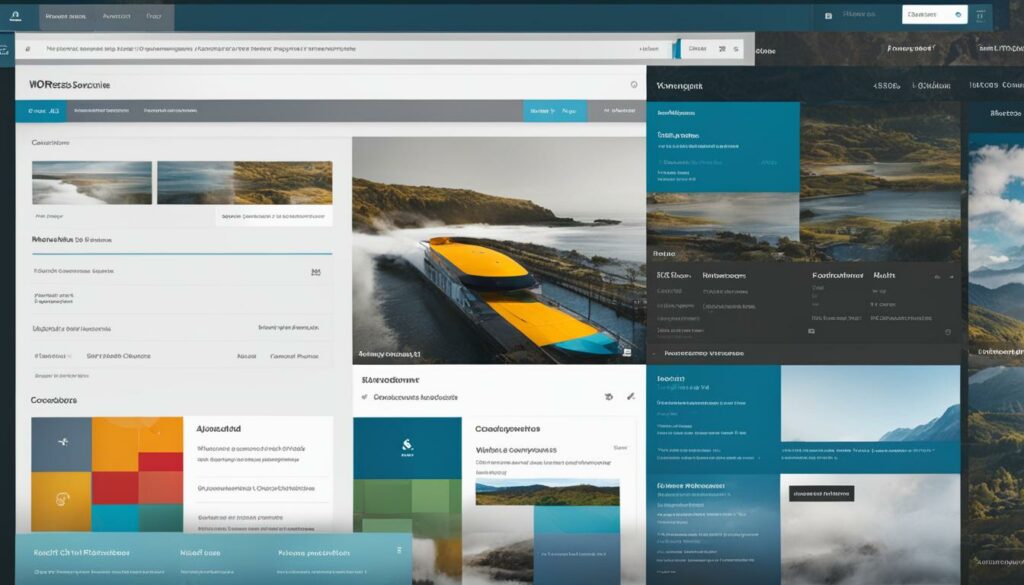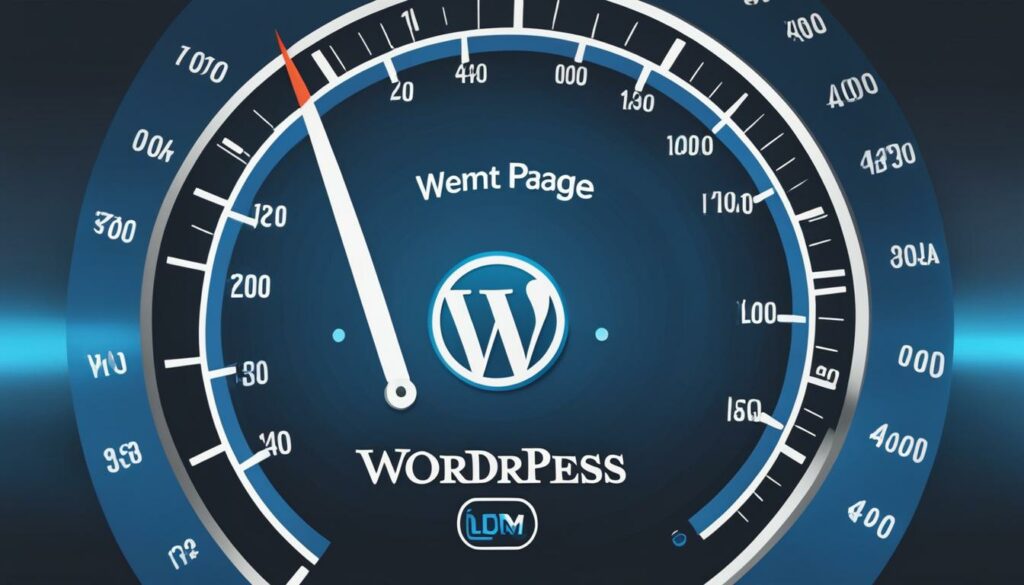Are you looking to optimize your WordPress website for better performance and improved search engine rankings? Conducting a thorough site audit is the key to achieving website excellence. A WordPress site audit involves assessing various aspects of your website, from its performance and functionality to its search engine optimization (SEO) and overall health.
During a WordPress site audit, you analyze your website, identify any technical issues, and implement necessary improvements to enhance user experience and meet your marketing objectives. Website audits help you uncover hidden potential, troubleshoot problems, and make informed decisions to optimize your website effectively.
Whether you’re maintaining an existing WordPress site or planning to launch a new one, a comprehensive website audit is essential to ensure its success. Let’s dive into the details of conducting a thorough WordPress site audit and discover how you can optimize your website for peak performance.
Key Takeaways:
- A WordPress site audit is crucial for maintaining website health, optimizing performance, and improving SEO.
- During a website audit, you can identify and resolve technical issues that may affect user experience.
- An audit helps you optimize your website for marketing objectives and ensure it meets industry standards.
- Regular audits and updates are necessary to keep your website functioning at its best.
- Consider using BoostedHost for WordPress Hosting to enhance your website’s performance.
Why You Need to Audit Your WordPress Site
Auditing your WordPress site is crucial to ensure it is fully functional, optimized, and running smoothly. A site audit helps identify and solve technical problems, optimize your site for marketing objectives, and improve user experience. It is important to regularly audit your WordPress site to maintain its performance and usability.
“A site audit helps identify and solve technical problems, optimize your site for marketing objectives, and improve user experience.”
A WordPress site audit is like giving your website a health check. It allows you to assess the overall performance and efficiency of your site, ensuring that it meets the necessary standards. By conducting regular site audits, you can identify and address any issues that may hinder your website’s success.
An audit involves a comprehensive examination of your website, including its design, content, functionality, and performance. It allows you to identify areas for improvement and make necessary updates to enhance your site’s performance and achieve your marketing objectives.
During a WordPress site audit, you can assess various aspects of your website, such as:
- Website load times
- Mobile responsiveness
- Navigation and user experience
- Website security
- Search engine optimization (SEO)
- Content quality and relevance
By examining these areas, you can optimize your website to attract more visitors, improve user engagement, and enhance your online visibility. Additionally, a site audit helps you stay up-to-date with the latest industry standards and best practices.
Optimizing Your Website for Marketing Objectives
Conducting a WordPress site audit allows you to align your website with your marketing objectives. By identifying potential areas for improvement, you can optimize your site to drive more conversions, increase customer engagement, and achieve your marketing goals.
For example, if one of your marketing objectives is to generate more leads through your website, a site audit can help you identify any barriers or friction points that may hinder lead generation. By optimizing your website’s forms, CTAs, and landing pages, you can create a more efficient and effective lead generation funnel.
Similarly, if your marketing objective is to improve your site’s search engine rankings, an SEO audit can uncover any technical issues or optimization opportunities. By optimizing your site’s meta tags, URLs, and content, you can improve your site’s visibility in search engine results and attract more organic traffic.
| Benefits of Auditing Your WordPress Site | Examples |
|---|---|
| Identifies technical issues | Broken links, slow page load times, compatibility issues |
| Optimizes site performance | Improving website speed, mobile responsiveness, user engagement |
| Enhances user experience | Streamlining navigation, improving content readability, simplifying form submission |
| Improves search engine rankings | Optimizing meta tags, URLs, and content for target keywords |
| Drives more conversions | Optimizing CTAs, landing pages, and conversion funnels |
Auditing your WordPress site is an ongoing process. Regularly monitoring and updating your site based on audit findings helps ensure that your website stays in peak condition and continues to support your marketing objectives.
Sign up for BoostedHost’s top-notch WordPress Hosting to optimize the performance of your website. BoostedHost offers reliable hosting services tailored specifically for WordPress sites, guaranteeing seamless functionality and superior site speeds. Don’t miss out on this opportunity to enhance your website’s performance with BoostedHost. Sign up now through this link: www.boostedhost.com/wordpress-hosting.
What to Check During a WordPress Site Audit
When conducting a WordPress site audit, it is crucial to thoroughly inspect various aspects of your website. By assessing and addressing these key areas, you can ensure that your site is optimized, secure, and user-friendly. Take a look at the checklist below to guide you through the audit process:
1. Forms Testing
Check the functionality of all forms on your WordPress site, including contact forms, subscription forms, and any other interactive forms. Test the submission process, validate input fields, and verify that automated responses are being sent correctly.
2. SEO Review
Perform a comprehensive review of your site’s SEO. Examine your meta tags, headings, and keyword usage to ensure they align with your SEO goals. Use tools like Yoast SEO or All in One SEO Pack to help optimize your content for search engines.
3. Site Security
Inspect your WordPress site’s security measures. Install security plugins like Wordfence or Sucuri to protect against malware and hacking attempts. Regularly update your plugins, themes, and WordPress core to address security vulnerabilities.
4. Site Analytics
Integrate a reliable analytics tool like Google Analytics to gather insights about your website’s performance. Monitor key metrics such as traffic, bounce rates, and conversions to identify areas for improvement and track the effectiveness of your marketing strategies.
5. Site Performance Metrics
Evaluate your site’s performance metrics to ensure fast loading times and optimal user experience. Use tools like GTmetrix or Pingdom to measure your site’s speed, identify bottlenecks, and optimize elements that may slow down your site’s performance.
6. Site Functionality
Test all interactive elements and features on your WordPress site, such as buttons, navigation menus, and multimedia elements. Verify that all links are functional, images are displaying correctly, and that user interactions are working as intended.
7. Mobile Responsiveness
Check the responsiveness of your WordPress site on various screen sizes, including mobile and tablet devices. Use Google’s Mobile-Friendly Test Tool to ensure your site is mobile-friendly and offers a seamless experience for users on the go.
8. Software Update Status
Regularly update your WordPress core, themes, and plugins to the latest versions. This ensures that your site is using the most secure and efficient code, preventing potential vulnerabilities and compatibility issues.
By thoroughly assessing these crucial aspects of your WordPress site, you can optimize its performance, enhance its security, and provide an exceptional user experience. This comprehensive audit checklist will help you identify any areas that require attention, ensuring that your website remains in optimal condition.
| Aspect | Actions |
|---|---|
| Forms Testing | Ensure all forms are functional and submission processes work smoothly |
| SEO Review | Optimize meta tags, headings, and keyword usage for better search engine visibility |
| Site Security | Install security plugins, update themes/plugins regularly, and address vulnerabilities |
| Site Analytics | Integrate analytics tools to track site performance and gather valuable insights |
| Site Performance Metrics | Measure site speed, identify and optimize factors affecting performance |
| Site Functionality | Test interactive elements, links, and multimedia for proper functioning |
| Mobile Responsiveness | Ensure site is optimized for mobile devices and provides seamless user experience |
| Software Update Status | Regularly update WordPress core, themes, and plugins for enhanced security and performance |
Locating and Testing Your Forms
During a WordPress site audit, one essential aspect to consider is locating and testing your forms. WordPress forms play a crucial role in various areas such as customer support, online orders, surveys, and more. It is imperative to audit your forms to ensure they are both fully functional and optimized to provide the best customer experience.
Locating your forms can be made easier with the help of tools like WPForms. This plugin allows you to easily locate and manage all your WordPress forms in one convenient location. With its user-friendly interface and intuitive features, WPForms simplifies the process of form management and optimization.
Once you have located your forms, testing them is equally important. Conducting thorough form testing ensures that customers can successfully complete their desired actions without any glitches or issues. By testing various form elements, including text fields, checkboxes, dropdown menus, and submit buttons, you can ensure a seamless and intuitive user experience.
Form testing should cover aspects such as validation and submission, ensuring that all required fields are properly validated and that forms are successfully submitted without any errors. By proactively identifying and fixing any issues that may arise during form testing, you can optimize your forms for a smooth and frustration-free customer experience.
Furthermore, form optimization involves streamlining and improving the overall performance of your forms. This includes optimizing form load times, reducing clutter, improving visual aesthetics, and enhancing mobile responsiveness. By implementing these optimizations, you can enhance the usability and effectiveness of your forms.
Overall, locating and testing your forms during a WordPress site audit is crucial for delivering an exceptional customer experience. By using tools like WPForms and conducting thorough testing and optimization, you can ensure that your forms are functioning flawlessly and provide a seamless user experience to your valued customers.
Reviewing Your Site SEO
An important part of conducting a WordPress site audit is reviewing your site’s SEO. Optimizing your site for search engines is crucial for improving its visibility and driving organic traffic. The AIOSEO plugin is a powerful tool that can help you audit and optimize your WordPress site’s SEO performance.
The AIOSEO plugin allows you to conduct a comprehensive SEO audit, including on-page optimization and link auditing. It analyzes your site’s metadata, content, and keywords to provide actionable suggestions for improving your SEO performance. With AIOSEO, you can ensure that your important pages are properly interlinked and optimized for search engines.
On-Page Optimization
On-page optimization is a crucial aspect of SEO. It involves optimizing your website’s content, structure, and tags to improve its visibility in search engine results. The AIOSEO plugin provides valuable insights and recommendations for optimizing your content for relevant keywords, improving meta titles and descriptions, and enhancing page load speed.
By following the on-page optimization recommendations provided by the AIOSEO plugin, you can enhance your site’s visibility in search engine rankings and attract more organic traffic.
Link Auditing
Link auditing is another essential aspect of SEO. It involves evaluating the quality and relevance of the links on your website. The AIOSEO plugin helps you identify broken or low-quality links that could impact your site’s SEO performance.
By reviewing and fixing these links, you can improve your site’s authority and credibility, leading to better search engine rankings and more organic traffic.

Checking WordPress Site Security
Your WordPress site’s security is of utmost importance. Without proper security measures, your website could be vulnerable to malware attacks and hacking attempts. It’s crucial to regularly review and enhance your site’s security to safeguard your data and protect your users.
User Activity Monitoring
Monitoring user activity on your WordPress site is an effective way to detect any suspicious behavior or unauthorized access. By keeping a close eye on user actions, you can identify potential security threats and take immediate action to mitigate them. Utilize security plugins that provide user activity monitoring features to stay proactive in safeguarding your site.
Two-Factor Authentication
Implementing two-factor authentication (2FA) adds an extra layer of security to your WordPress site. With 2FA, users are required to provide a second form of verification, such as a unique code sent to their mobile device, along with their username and password. This additional step makes it significantly harder for hackers to gain unauthorized access to your site.
Security Plugins
Enhance your WordPress site’s security by utilizing reliable security plugins. These plugins offer features such as firewall protection, malware scanning, and real-time threat detection. One popular security plugin is Sucuri, which provides comprehensive security solutions to keep your site safe from potential vulnerabilities.
Image: WordPress Site Security
| Benefits of Ensuring WordPress Site Security | Security Measures |
|---|---|
| Protection against malware and hacking attempts | Regular monitoring of user activity |
| Enhances user trust and confidence | Implementation of two-factor authentication |
| Mitigates potential data breaches | Utilization of reliable security plugins |
| Regular updates and patches |
Monitoring Site Analytics
Monitoring site analytics is an integral part of a WordPress site audit. Analyzing metrics such as page views, bounce rates, and conversion rates helps you understand your site’s performance and identify areas for improvement. By closely examining these data points, you can make data-driven decisions to optimize your site for better results.
One valuable tool for monitoring site analytics is MonsterInsights. With its robust tracking features and user-friendly interface, MonsterInsights simplifies the process of gathering and analyzing important data. It integrates seamlessly with WordPress, allowing you to track key metrics without any coding knowledge.
When conducting a WordPress site audit, pay attention to the following analytics:
- Page Views: This metric shows the number of times a page on your site has been viewed. High page views indicate an engaged audience, while low page views may suggest content or usability issues.
- Bounce Rates: Bounce rate refers to the percentage of visitors who leave your site after viewing only one page. A high bounce rate can indicate poor site design, irrelevant content, or slow loading times.
- Conversion Rates: Conversion rates measure the percentage of visitors who complete a desired action on your site, such as making a purchase or filling out a form. Tracking conversion rates can help you assess the effectiveness of your marketing and optimization efforts.
By regularly monitoring and analyzing these metrics, you can gain insights into user behavior, identify areas for improvement, and implement conversion optimization strategies to enhance the performance of your WordPress site.
Key Benefits of Monitoring Site Analytics:
“The more you understand your site’s analytics, the better equipped you are to optimize your site for improved traffic, user engagement, and conversions.”
Here are a few key benefits of monitoring site analytics:
- Identify Top Performing Pages: Analytics help you determine which pages are attracting the most traffic and engagement. By focusing on these pages, you can optimize them further to maximize results.
- Pinpoint User Behavior: Analyzing the behavior flow of your visitors provides insights into where they enter and exit your site, what content they engage with, and how they navigate through your site. This information allows you to optimize the user experience to encourage desired actions.
- Tracking Marketing Campaigns: Site analytics enable you to measure the effectiveness of your marketing campaigns. By tagging your campaigns and monitoring the associated metrics, you can identify which campaigns are driving the most traffic and conversions.
- Conversion Optimization: By understanding user behavior and identifying bottlenecks in the conversion process, you can make data-driven decisions to optimize your site for better conversion rates. This may involve tweaking landing page designs, improving call-to-action placement, or simplifying the checkout process.
With the right analytics tools and a deep understanding of your site’s performance, you can continuously improve the effectiveness of your WordPress site and achieve your marketing goals.

Remember, monitoring site analytics is an ongoing process. Make it a habit to regularly review your site’s performance, track the impact of any optimizations, and refine your strategies accordingly. By leveraging the insights gained from analytics, you can drive more traffic, improve user engagement, and boost conversions on your WordPress site.
Checking Site Performance Metrics
When it comes to your WordPress site, performance is everything. You want your site to load quickly and provide a seamless user experience. That’s why checking site performance metrics is a crucial step in conducting a thorough WordPress site audit.
One helpful tool for measuring site performance is GTmetrix. It provides a comprehensive report that analyzes key metrics such as website speed and performance optimization. By examining the GTmetrix report, you can identify areas for improvement and take steps to enhance your site’s performance.
Here are some key performance metrics to consider:
- Website speed: A slow-loading site can lead to high bounce rates and frustrated users. GTmetrix measures your site’s loading time and offers suggestions for speeding it up.
- Page size: Large page sizes can slow down your site. GTmetrix identifies the file sizes of your website elements and recommends ways to reduce them.
- Page requests: The number of HTTP requests made by your site affects its load time. GTmetrix provides insights into the number of requests and offers solutions to minimize them.
Additionally, GTmetrix evaluates your site’s use of uncompressed media, optimization of images, and reduction of CSS elements. Following the recommendations provided by GTmetrix can help optimize your site’s performance, leading to improved user satisfaction and better search engine rankings.
| Metric | Description |
|---|---|
| Website Speed | The time it takes for your site to load. A faster loading time enhances user experience and improves SEO. |
| Page Size | The total file size of your webpage, including text, images, scripts, and other elements. Smaller page sizes result in faster loading times. |
| Page Requests | The number of HTTP requests made to load your webpage. Minimizing the number of requests can reduce load time. |
By regularly checking site performance metrics and implementing optimization strategies, you can ensure your WordPress site delivers a lightning-fast experience for your visitors.
Testing WordPress Site Functionality
When conducting a WordPress site audit, it is crucial to thoroughly test the functionality of your website. This step ensures that all interactive elements, such as forms, buttons, and navigation, are working correctly. By auditing your site’s functionality, you can identify and address any broken or malfunctioning elements, providing visitors with a seamless user experience.
During the audit, it is essential to test not only the basic functionality of these elements but also their compatibility across different devices and browsers. This ensures that all users, regardless of their chosen platform, can fully engage with your website.
Additionally, formatting testing is an integral part of this process. Checking the formatting of your content, including text, images, and media, helps maintain consistency and readability throughout your site. By confirming that your formatting is consistent and error-free, you can create a visually appealing and user-friendly experience for your visitors.
Incorporating code and design component testing is another important aspect of auditing WordPress site functionality. By reviewing the underlying code structure and testing design elements, you can ensure that your website is optimized for performance and aesthetics.
Testing WordPress Site Functionality Checklist:
- Verify that all forms, such as contact forms or subscription forms, are functioning properly.
- Test interactive elements, including buttons, dropdown menus, and navigation menus, for responsiveness and accuracy.
- Ensure that links throughout your site are working correctly and directing users to the intended destinations.
- Validate the compatibility of your website across different devices, browsers, and operating systems.
- Review the formatting of your content, ensuring consistency in font styles, colors, and layouts.
- Test the loading speed of your website, identifying any performance issues that may impact user experience.
- Check for broken images or videos and ensure their proper display.
By thoroughly testing the functionality of your WordPress site, you can address any issues, optimize user experience, and provide visitors with a seamless browsing experience.

Checking Mobile Responsiveness
With a large percentage of users accessing websites through mobile devices, it is crucial to ensure that your WordPress site is mobile-responsive. A mobile-friendly design not only provides a better user experience but also positively impacts search engine rankings. One effective tool for evaluating the mobile responsiveness of your site is Google’s Mobile-Friendly Test Tool.
By using this tool, you can analyze how well your site adapts to different screen sizes and identify any areas that need improvement. The Mobile-Friendly Test Tool examines various aspects, including font sizes, content spacing, and clickable elements, to determine if your site is optimized for mobile viewing.
Improving mobile responsiveness goes beyond creating a visually appealing site on mobile devices; it ensures a seamless experience for mobile users. Optimize your site’s layout, images, and content to make it easy to navigate and interact with on smartphones and tablets.
Conclusion
Conducting thorough WordPress site audits is essential for maintaining website performance, optimizing for SEO, and providing a great user experience. By following the steps mentioned in this article, you can ensure your WordPress site is fully functional, secure, and well-optimized.
Regular audits and updates will keep your site at its best and help you achieve your marketing objectives. Remember to regularly check your forms for smooth customer interactions and optimize your site’s SEO using plugins like AIOSEO to improve rankings and on-page optimization.
Ensuring the security of your WordPress site is paramount. Monitor user activity, enable two-factor authentication, and utilize security plugins such as Sucuri to safeguard your website from potential threats.
Additionally, regularly monitoring site analytics, performance metrics, and mobile responsiveness will provide valuable insights to enhance user experience and improve search engine rankings. Remember, a seamless user experience and fast-loading pages can make a significant difference in retaining visitors and driving conversions.
FAQ
Q: Why is it important to conduct a WordPress site audit?
A: Conducting a WordPress site audit ensures that your website is fully functional, optimized, and running smoothly. It helps identify and solve technical problems, optimize your site for marketing objectives, and improve user experience.
Q: What should I check during a WordPress site audit?
A: During a WordPress site audit, it is important to check various aspects of your website, including forms testing, SEO review, site security, site analytics, site performance metrics, site functionality, mobile responsiveness, and software update status. These areas help ensure your site is optimized, secure, and user-friendly.
Q: How can I locate and test my WordPress forms?
A: To locate and test your WordPress forms, you can use tools like WPForms. Auditing your forms helps ensure they are fully functional and optimized for the best customer experience.
Q: How can I review the SEO of my WordPress site?
A: You can conduct a comprehensive SEO audit of your WordPress site using the AIOSEO plugin. This audit includes on-page optimization and link auditing, and provides actionable suggestions for improving your SEO performance.
Q: What should I do to enhance the security of my WordPress site?
A: To enhance the security of your WordPress site, you can monitor user activity, enforce two-factor authentication, and use security plugins like Sucuri. These measures help protect your site from malware and hackers.
Q: How can I monitor the analytics of my WordPress site?
A: You can monitor the analytics of your WordPress site by analyzing metrics such as page views, bounce rates, and conversion rates. Tools like MonsterInsights provide valuable insights and help you make data-driven decisions to optimize your site for better results.
Q: What should I check to ensure optimal site performance?
A: To ensure optimal site performance, you should check key performance metrics using tools like GTmetrix. This helps identify areas for improvement, such as optimizing images, reducing CSS elements, and minimizing the use of uncompressed media.
Q: Why is testing the functionality of my WordPress site important?
A: Testing the functionality of your WordPress site is important to ensure all interactive elements, such as forms, buttons, and navigation, are working correctly. Auditing your site’s functionality helps detect any broken or malfunctioning elements and ensures a smooth user experience.
Q: How can I check the mobile responsiveness of my WordPress site?
A: You can check the mobile responsiveness of your WordPress site using tools like Google’s Mobile-Friendly Test Tool. This evaluation helps determine if your site is optimized for mobile devices and ensures a seamless experience for mobile users.
Q: Why should I conduct regular WordPress site audits?
A: Conducting regular WordPress site audits is essential for maintaining website performance, optimizing for SEO, and providing a great user experience. By regularly auditing and updating your site, you can ensure it remains fully functional, secure, and well-optimized.












